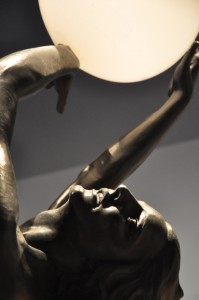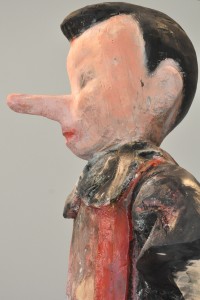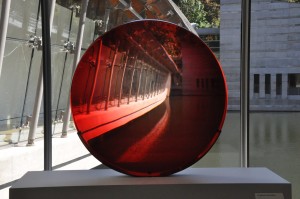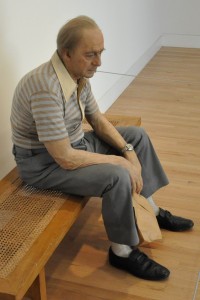I want to be snarky. I want to be elitist and scorn cultural credibility bought by Walmart money.
I am not altogether succeeding.
Fact is, the Crystal Bridges Museum of American Art is pretty damned amazing.
It has the best collection of American moderns that I have seen anywhere other than the Boston Museum of Fine Art. That density starts with the Ash Can painters and moves on from there. It has more Martin Johnson Heades than I have seen anywhere. There are two superior portraits by 18th-century luminary, John Singleton Copley, extraordinary American Impressionists, and delightful trompe l’oeil paintings including a number by John F. Peto.
Quantity and quality both left me gobsmacked. Founder and funder Alice Walton relied on the erudition and connections of John Wilmerding (PhD, Harvard University; Christopher B. Sarofim ’86 Professor in American Art, Emeritus, Princeton University; former Senior Curator and Deputy Director, the National Gallery of Art, Washington DC) and it shows. Artists are collected in depth and many of the works are masterpieces. The collection provides a scholarly overview of American art of the late eighteenth through early twentieth centuries. (While there is remarkable representation of the surrealist phase of the New York School, and admirable works by the contemporaneous representational painters like Milton Avery (1885-1965), Fairfield Porter (1907-75) and Will Barnet (1911-2012), the late twentieth- and early twenty-first-century holdings are notable for a preference for realism and figuration. We started our tour in the twentieth century and reviewed the collections “backward,” my jaw dropping every closer to the ground as we progressed.
However I have issues. When Ms. Walton initiated this project, one of her first acquisitions was Asher Durand’s Kindred Spirits (1849), the touchstone of American painting and Transcendentalism. She bought the painting from the New York Public Library, where it had resided since 1904, a gift from the Julia Bryant, daughter of the poet William Cullen Bryant whose friendship with the painter Thomas Cole the work celebrates. The sale was castigated by many, and as it says in Art in Nature: Crystal Bridges Museum of American Art (2013), “Alice Walton herself was characterized…as an art ‘vulture:’ snapping up American masterworks to hide them away in a remote Ozark lair.” (p.5) Her next target was The Gross Clinic (1875) by Thomas Eakins. Fortunately area institutions—the Philadelphia Museum of Art and the Pennsylvania Academy of Fine Art—joined forces to buy the painting from the Jefferson Medical College and keep it where it belongs.
Then we passed locked doors papered with advertisements for an exhibition that will open next month: The Artists’ Eye: Georgia O’Keeffe and the Alfred Stieglitz Collection. According to the Philanthropy News Digest online, “Under the agreement approved by Davidson County Chancery Court, the 101-piece collection — which was donated to the university by Georgia O’Keeffe in 1949 on the condition that it be kept intact, on display, and never sold — will be rotated between Fisk and Crystal Bridges every two years.” The deal was finalized in the summer of 2012. I am pretty darned sure this is not what Georgia O’Keeffe wanted.
This wasn’t exactly deaccessioning—tricky territory at best and something the courts explicitly prohibited. It was darned near deaccessioning, though. It was selling fifty percent every work for cash that would be used to cover institutional debts rather than contribute to the acquisition of new objects for the collection. Crystal Bridges paid thirty million for their half interest in a collection worth—historically and in terms of market values—more than sixty million, at least in my opinion. One can only imagine how much salivating was going on in those bridges over Crystal Spring when the bankruptcy manager in Detroit was speculating about selling off the collections of the Institute of Art.
Something is rotten in the states of Arkansas and Tennessee, and beyond. And the American Alliance of Museums should have had the balls to say something about this.
The more time I spent in the galleries, though, the less I liked what I saw. This wasn’t a matter of bad thoughts about acquisitions policies, but issues about the installation and interpretive structures. The approach to hanging reminds me, somewhat bizarrely, of the Barnes Foundation in Philadelphia: lots of formal similarities but little contextual or historical meaning. Where an individual artist is represented by many works—artists like Martin Johnson Heade, Alfred Maurer, Stuart Davis and Milton Avery, for example—objects show up all over the place in ways that undermine the visitor’s ability to develop a complex and nuanced appreciation of them. Works by husbands and wives (such as Thomas Wilmer Dewing and Maria Oakey Dewing) are not only separated into different areas, but no effort is made to connect them formally or historically.
In the eighteenth- and nineteenth-century areas, particularly, the approach seems to be, “We’ve got it and we’re gonna flaunt it.” Heade, certainly, could and should be cut back, starting with the sixteen “Gems of Brazil” paintings of hummingbirds and butterflies, and the dozen or more Heade sketches on the obverse of that wall. The density of the installation evokes to floor-to-ceiling excesses of annual Salons. Works from the second half of the twentieth century and the first decade of the twenty-first are spotty in quality and safe and decorative more than interesting.
Part of the problem is related to Safdi’s exhibition spaces. It is unclear to me how those galleries with their curving walls and open vistas might be used more effectively to present works and elucidate their relationships. The buildings are gorgeous. Exhibition space seems constrained, limited. Are they good spaces for showing art? Not for me. It’s anyone’s guess about how much real estate has been provided for administration functions, conservation and installations functions, and education.
A little poking around on the Internet also showed that all is not well in this new museum. None of the original four senior administrators is still in place. Director Don Bacigalupi was been “promoted” to president of the Board; Deputy Director for Operations and Administration, Rod Bigelow (an administrator but not really an art guy) is now Executive Director. Founding curator Chris Crosman no longer occupies the job he fully believed would last beyond the opening of the museum; curatorial director David Houston is in a new job in Georgia; Matt Dawson, Deputy Director for Art and Education is gone and there is no plan to refill that position (and therefore no plans to have a senior staff member overseeing interpretation and programming as they related to the collections). Most recently, Kevin Murphy, curator of American Art, just went to a professorship and museum job at Williams College. There has been one hire: an “Assistant Curator for Special Projects.” Chad Allgood has excellent credentials but he’s youthful and his job title appears peripheral to any core mission. Do I need to point out that the upper echelons appear devoid of women? I find it unlikely that there were no qualified female applicants for any of these positions.
What this says to me is that the museum is indeed something of a vanity project for Alice Walton. The vision for a great museum of American art in this culturally underserved area is as much about personal fame and social cachet as it is about aesthetic delight, scholarship, and a future rich with democratic opportunity. In the end I wish them well—because I could only wish well for any art museum and especially one that potentially represents so much to so many. I just wish that the Walton wealth and ambition that made Crystal Bridges Museum of American Art possible isn’t going to be the hubris that destroys careers and condemns such wonderful works to seclusion in a “remote Ozark lair.”





